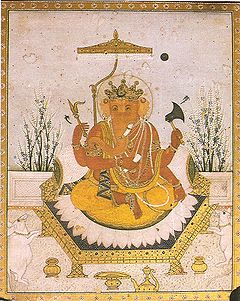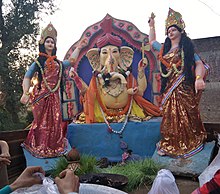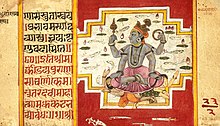
Bhadra or Bhadrapada or Bhādo or Bhadraba (Bengali: ভাদ্র bhādro; Hindi: भादों bhādo; Sanskrit: भाद्रपद bhādrapada; Nepali: भाद्र Bhādra; Odia: ଭାଦ୍ରବ Bhadraba; Assamese: ভাদ) is the sixth month of the Hindu calendar, which falls in August and September of the Gregorian calendar. In India's national civil calendar, Bhadra is the sixth month of the year, beginning on middle of August and ending on middle of September. In Hindu astrology, Bhadra begins with the Sun's entry into Leo and is usually the fifth month of the year.

Ganesh Chaturthi, also known as Vinayaka Chaturthi or Vinayaka Chavithi or Vinayagar Chaturthi, is a Hindu festival that tributes Hindu deity Ganesha. The festival is marked with the installation of Ganesha's clay murtis privately in homes and publicly on elaborate pandals. Observances include chanting of Vedic hymns and Hindu texts, such as prayers and vrata (fasting). Offerings and prasada from the daily prayers, that are distributed from the pandal to the community, include sweets such as modak as it is believed to be a favourite of Lord Ganesha. The festival ends on the tenth day after start, when the Murti is carried in a public procession with music and group chanting, then immersed in a nearby body of water such as a river or sea, called visarjana on the day of Ananta Chaturdashi. In Mumbai alone, around 150,000 Murtis are immersed annually. Thereafter the clay Murti dissolves and Ganesha is believed to return to his celestial abode.

Hanuman Jayanti is a Hindu festival celebrating the birth of the Hindu deity, and one of the protagonists of the Ramayana and its many versions, Hanuman. The celebration of Hanuman Jayanti varies by time and tradition in each state of India. In most northern states of India, the festival is observed on the full-moon day of the Hindu month of Chaitra. In Karnataka, Hanuman Jayanti is observed on Shukla Paksha Trayodashi, during the Margashirsha month or in Vaishakha, while in a few states like Kerala and Tamil Nadu, it is celebrated during the month of Dhanu. Hanuman Jayanti is observed on Pana Sankranti in the eastern state of Odisha, which coincides with the Odia New Year.

Varadvinayak, also spelt as Varadavinayaka, is one of the Ashtavinayak temples of the Hindu deity Ganesha. It is located in Mhad village situated in Khalapur taluka near Karjat and Khopoli of Raigad District, Maharashtra, India. The temple was built (restored) by Peshwa General Ramji Mahadev Biwalkar in 1725AD.

Chaturthi refers to the fourth day of a lunar fortnight in the Hindu calendar.

Shri Swaminarayan Mandir, Mumbai is a Hindu temple (Mandir) and a part of the Swaminarayan Sampraday. This Swaminarayan Temple is located in the Bhuleshwar area of Mumbai and is the oldest Swaminarayan Mandir in Mumbai, being over a hundred years old.
The Dashabhuja Temple is a Hindu temple in Pune, in the Maharashtra state of India. This temple was once owned by Sardar Haripant Phadke, a Sardar of Peshwa and was later donated to the Peshwas as dowry. Dashabhuja Ganapati temple is visited by thousands of devotees every day and the number increases during Ganesh Chaturthi. The idol of Ganpati or Ganesh seen here has his elephant trunk resting on his right-hand side, which is supposed to be rarer and more sacred than other forms of the Ganesh idol.

Morya Gosavi or Moraya Gosavi alias Moroba Gosavi was a prominent saint of the Hindu Ganapatya sect, which considers Ganesha as the Supreme God. Morya Gosavi is considered the chief spiritual progenitor of the Ganapatyas and has been described as the "most famous devotee" of Ganesha.

The Dagadusheth Halwai Ganapati temple is a Hindu Temple located in Pune and is dedicated to the Hindu god Ganesh. The temple is visited by over hundred thousand pilgrims every year. Devotees of the temple include celebrities and chief ministers of Maharashtra who visit during the annual ten-day Ganeshotsav festival. The main Ganesh idol is insured for sum of ₹10 million (US$130,000). It celebrated 130 years of its Ganapati in 2022.

Sankashti Chaturthi, also known as Sankatahara Chaturthi and Sankashti, is a holy day in every lunar month of the Hindu calendar dedicated to the Hindu god Ganesha. This day falls on the fourth day of the Krishna Paksha. If this Chaturthi falls on a Tuesday, it is called Angaraki Sankashti Chaturthi, Angaraki Chaturthi, Angaraki and Angarika. Angaraki Sankashti Chaturthi is considered highly sacred.

The Siddhivinayaka Mahaganapati Temple is a Hindu temple located in Titwala, a small town in the Kalyan taluka of Thane district – near Mumbai, Maharashtra, India. The temple is dedicated to the Hindu, elephant-headed god of wisdom Ganesha. Titwala is believed to be the putative site of the hermitage of sage Kanva, foster parent of Shakuntala who was born here. The place is steeped in ancient legend and the temple is frequented by a very large number of devotees on account of the belief that separated married couples could be united and marriages of desired people could be fixed easily if the Ganesha image installed in the temple is worshipped with devotion.This temple is frequented mostly on Tuesdays.

Shri Mayureshwar Mandir or Shri Moreshwar Temple is a Hindu temple (mandir) dedicated to Ganesha, god of wisdom. It is located in Moragaon in Pune District, about 65 km away from Pune city in the Indian state of Maharashtra. The temple is the starting and ending point of a pilgrimage of eight revered Ganesha temples called Ashtavinayaka.
Urkeri is a small village located in the district of Uttar Kannada in the state of Karnataka in India. It has a population of about 963 persons living in around 214 households. Urkeri is a temple Village. The main deity is Lord Ganesh. Lord Ganesha is revered as the village God in these villages, in the north Kanara district. The chariot ceremony of Ganapati is celebrated on Maghi Pournima. The temple is the main attraction at Urkeri, receiving many devotees per year. Urkeri Shree Swayambhoo Devasthana is an ancient temple.
Haragapur is a village in Belgaum district in the southern state of Karnataka, India. It is attached to NH-4. Places to visit are Shivaji Fort, Mallikarjun Temple & Navanath Mandir. Village is located on Hilltop. Language spoken here is Kannada

The Chintamani Temple of Theur is a Hindu temple dedicated to Supreme God Ganesha according to Ganapatya Sect located 25 km (16 mi) from Pune, the temple is "one of the larger and more famous" of the Ashtavinayaka, the eight revered shrines of Ganesha in the Indian state of Maharashtra.

The Siddhivinayak Temple of Siddhatek is a Hindu temple dedicated to Ganesha, the elephant-headed god of wisdom. The temple is one of the Ashtavinayaka, the eight revered shrines of Ganesha in the Indian state of Maharashtra and the only Ashtavinayaka shrine in Ahmednagar district.

The Vigneshwara Temple or Vighnahar Ganapati Temple of Ozar is a Hindu temple dedicated to Ganesha, the elephant-headed god of wisdom. The temple is one of the Ashtavinayaka, the eight revered shrines of Ganesha in Maharashtra, India. The Ganesha form worshipped here is called Vigneshwara or Vignahar and is associated with the legend of Ganesha defeating Vignasura, the demon of obstacles.
Here is a list of glossary of Culture of India in alphabetical order:
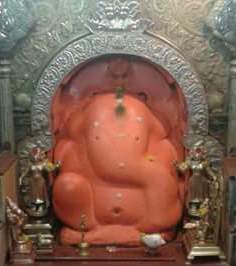
Sukhakarta Dukhaharta, also spelled as Sukhkarta Dukhharta, is a popular Marathi arati, song or bhajan dedicated to the Hindu god Ganesha, composed by the saint Samarth Ramdas. It is included in the "most standard and almost universal" aarti songs sung at the end of Puja of Ganesha in Maharashtra, especially in his festival Ganesh Chaturthi as well as in Ganesha temples in the region.
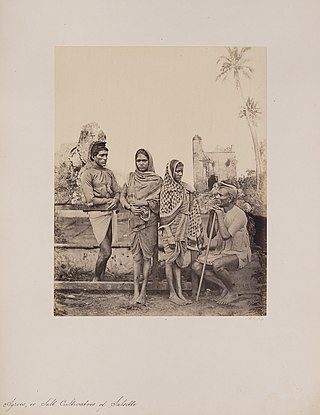
The Agri or Aagri are a mostly Hindu caste found in Mumbai (Bombay), Thane District, Raigad District & Palghar district of Konkan division, Maharashtra, India. The Agri population numbered around 416,000 in India in year 1931 They are mainly involved in fishing, salt making, and rice farming. They speak the Agri dialect of Maharashtrian Konkani and write in the Devanagari script. They are Hindus, worship all the Hindu deities and observe Hindu festivals such as Holi, Ganesh Chaturthi, Dussera, Diwali, Hanuman Jayanti, Datta Jayanti, Shiv Jayanti and others.
